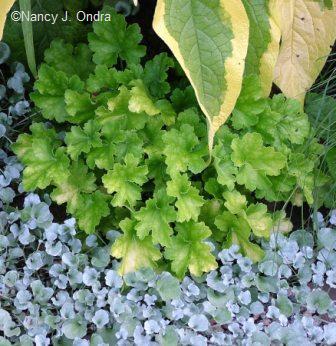 When I read that Fran had chosen heuchera as the GGW Plant Pick of the Month, I was pretty psyched. The plants have such a tidy, mounded habit and handsome leaf shape that they immediately come to mind when I’m looking for a hardy foliage plant in the front-of-the-border height range. And well, with such incredible colors and markings to choose from, what’s not to like about heucheras? Ah, yeah, that’s where reality sets in. I adore heucheras, but they sure don’t feel the same about me.
When I read that Fran had chosen heuchera as the GGW Plant Pick of the Month, I was pretty psyched. The plants have such a tidy, mounded habit and handsome leaf shape that they immediately come to mind when I’m looking for a hardy foliage plant in the front-of-the-border height range. And well, with such incredible colors and markings to choose from, what’s not to like about heucheras? Ah, yeah, that’s where reality sets in. I adore heucheras, but they sure don’t feel the same about me.
Those of you who have been gardening for twenty-some years may remember how exciting it was when we first got to try ‘Dale’s Strain’, a seed strain of Heuchera americana that often produces seedlings with a bit more purple center staining and silvery marbling than the straight species of alumroot. Those did pretty well in my old garden. And ‘Palace Purple’ too: how exciting it was to have that deep purple foliage!
Then came the thrillingly variegated ‘Snowstorm’, a white-speckled selection of H. sanguinea. My failure with that one was the first disappointment with heucheras, but I sure wasn’t going to give up on them, especially when each year after that brought more and more thrilling foliage variations. So year after year, I was more than happy to treat myself to at least one or two of the newest beauties.
I guess it’s the memory of my early successes with heucheras, and the fact that they look so gorgeous in photos and in nursery pots, that has blinded me to the fact that I’ve wasted a whole lot of money since then on plants that really don’t want to grow where I want them to. I mean, there’s the old saying about “you don’t really know a plant unless you’ve killed it three times.” But I figured I just didn’t know heucheras as well as I thought because I didn’t try the exact same cultivar three times; I kept trying (and killing) different ones. Maybe that doesn’t make a lot of sense, but it’s the best logic I can come up with for my unrequited passion for these plants.
A few years ago, I tried to change my expectations and think of the fantastic foliage heucheras as just really expensive annuals. One summer, I managed the combo above, with ‘Lime Rickey’ heuchera, ‘Silver Falls’ ponyfoot (Dichondra argentea), and ‘Axminster Gold’ Russian comfrey (Symphytum x uplandicum). But even then, the heucheras still did the incredible-shrinking-plants routine: They looked great in May and June and dwindled away
